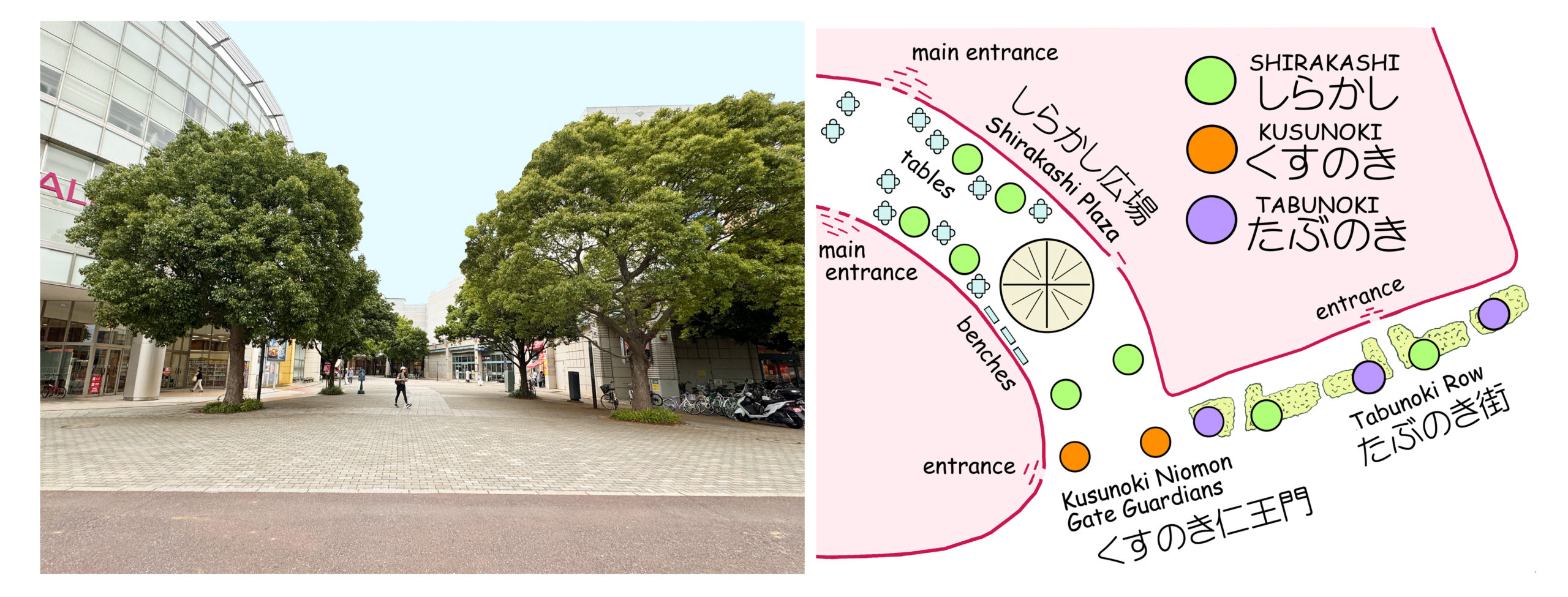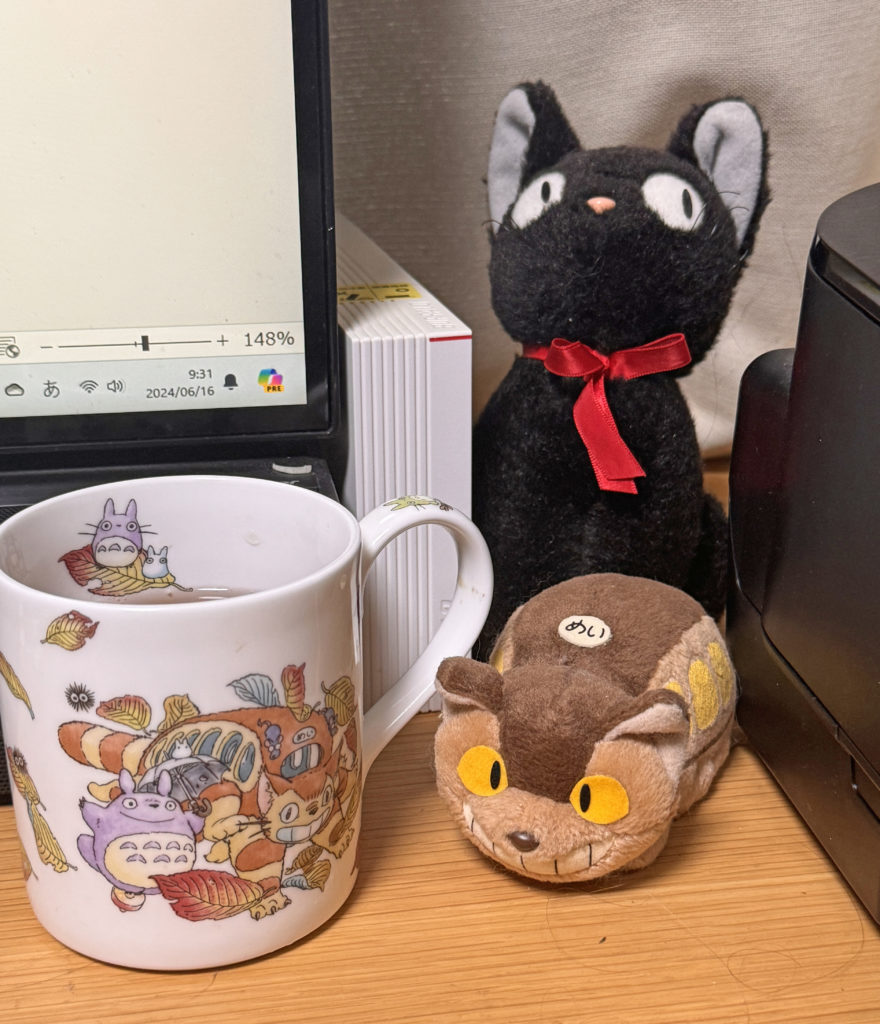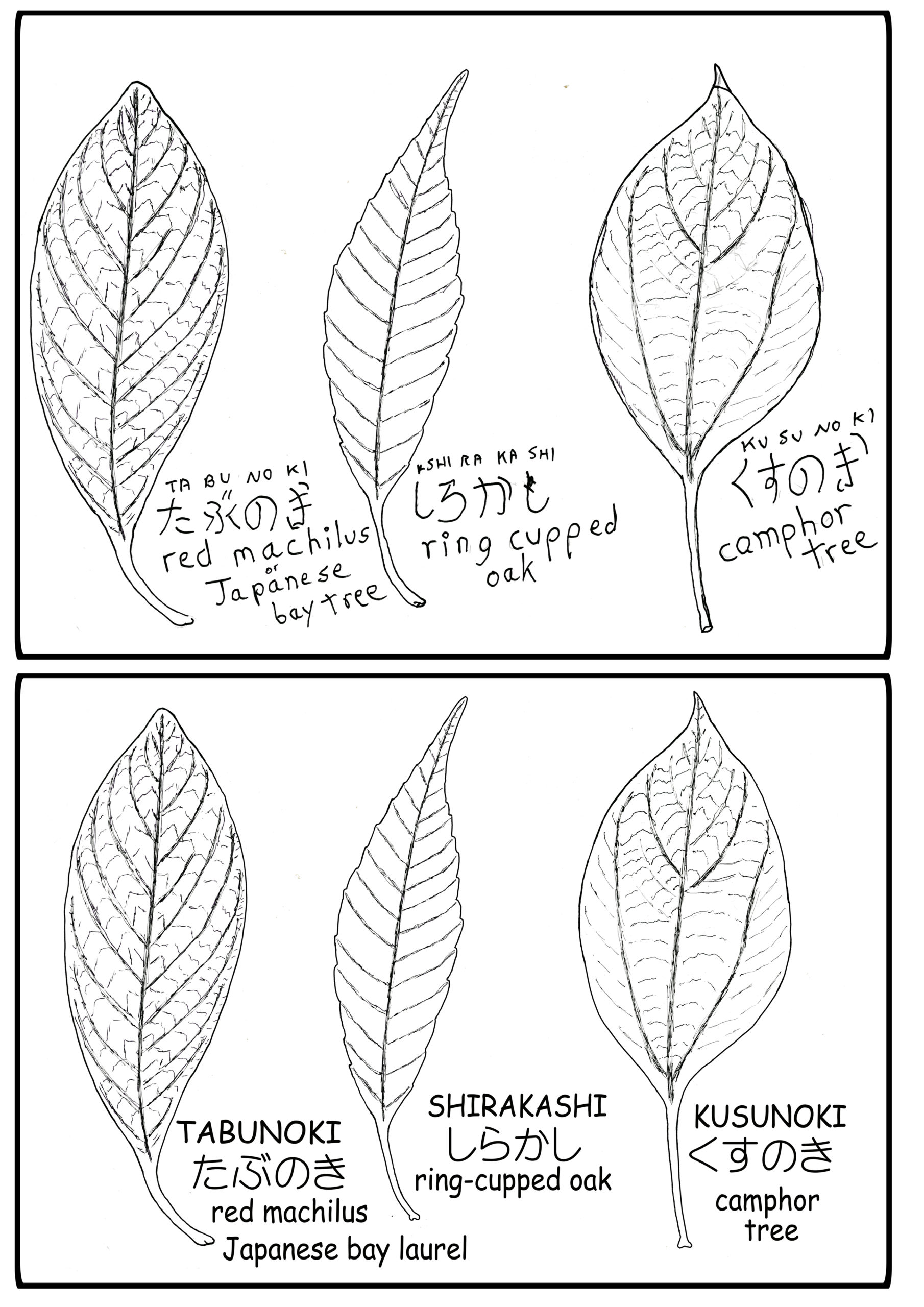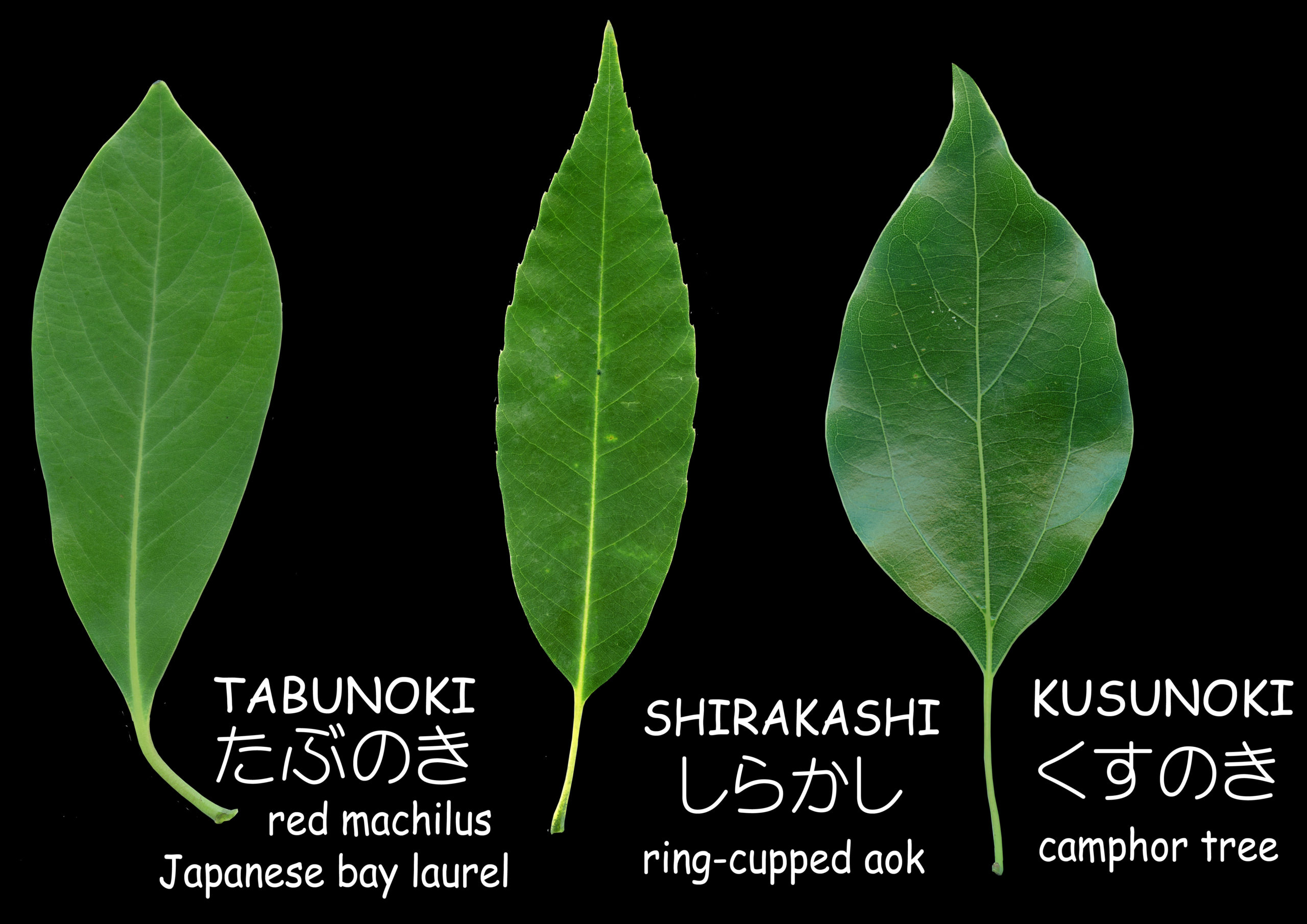我々ナチュラリストは「足元から・・」という考え方を非常に重要視している。足元の小さな自然や文化に触れ、観察して、記録して、感動して、驚いて、その経験から日常に薄れつつあるセンス・オブ・ワンダーを取り戻すことが出来る。足元って、場所を選ばない。自宅の庭や周辺地域、近くの公園、愛犬の散歩道、ショッピングに行く道、通勤や通学も道など、さまざまな身近な場所は楽しい足元フィールドへと変わる。
しかし、実は「足元から・・」には、「世界へ」と続く。つまり、足元で得た感動や知識はどんどん増えて、そこからは興味や関心がさまざまな方向に触れ挙がってゆく。すぐそばの足元もあくまでも地球の一部であり、広い世界に通じている。
例えば、千葉ニュータウン中央駅の北側に大きなショッピングモールが整備され、その中央には椅子とテーブルが並ぶ野外プラザがある。このプラザはぼくのお気に入りの場所、コーヒーを飲みながら一休みすることが多い。また、プラザの周囲に何本の大きな樹木はいつも心地よい日陰を提供してくれる。もちろん、これらの樹木はナチュラリストの好奇心を掻き立てて、絶好な足元フィールドとなる。
足元の情報を整理するためには、シンプルな地図を作製するのが非常に役立つ。ぼくはますます、プラザとその周囲に生える樹木13本の位地を描いた図面を作成した。そして次は各木から落ちた葉を拾い集め、コーヒーを飲みながらその観察に取り組んだ。ボタニカルアートは専門家にお任せするとしても、葉の簡単なフィールドスケッチならだれだって挑戦できる。目的はその葉を知り、その木と仲良くするための特徴を把握すること。形だけではなく、基部や先端、縁、葉柄、葉脈の様子にも注意を払う。

プラザの縁に生える6本の木は皆同じ種類、葉は全体的に細長く、先が鋭く尖がっている。葉の縁には浅い「鋸歯」(きょし)と呼ばれるギザギザが並んでいる。一方、まるで寺院の仁王様のようにプラザの南門を見守る2本の木は、葉の幅が広くて、縁に鋸歯がない。特に覚えやすい特徴は側脈のパターン。プラザの木の葉の側脈は一定の間隔で真っ直ぐに縁に向かって走る魚の骨や鳥の羽のようなパターンを示すが、この木の葉は2本の太い側脈が主脈の根本から出て、綺麗なカーブを描きながら先端近くに到る。
ショッピングモールの南東入り口付近には、三種類目の樹木が3本立っている。葉は先端がやや尖がり、縁にはギザギザがない。葉脈パターンは鳥の羽タイプ。他の2種類と比べると、基部は少し細く、くさび形。
ここで出会った木はシラカシ、クスノキ、そしてタブノキ。これら3種は冬にも葉が残るから、「常緑広葉樹」の仲間に属する。葉は手に取ると、ケヤキやサクラなどの落葉樹と比べると厚くて丈夫であることがよく分かる。さらに、葉の表面にはクチクラ層が発達して、太陽の光を浴びるときらきら美しく輝くから、「照葉樹」(しょうようじゅ)とも呼ばれる。同じような照葉樹は南と西日本の暖かい地域に分布し、「照葉樹林」という森のタイプを成している。

シラカシとタブノキは日本の照葉樹林の中で大きな役割を果たしているが、三種の中で最も有名なのはクスノキ。この木の知名度が一気に広まったのは1988年、スダジオジブリ作製の長編アニメ映画「となりのトトロ」の公開による。この作品は、時代設定が1950年代、高度経済成長期前夜、舞台は東京都と埼玉県の堺にまたがる狭山丘陵と設定されている。物語は、小学校3年生のサツキと妹のメイ(5歳)が、考古学者のお父さんと緑豊かな里山集落に引っ越してくることから始まる。この映画は、経済高度成長期以前の里山原風景がお見事に描き、全国の里山ファンから深い愛情を受けている。に深く愛されている。ぼくもこの映画を見た以来、スダジオジブリのアニメに夢中になった。まー、ジブリ・オタクと言えるだろう!
サツキたちの引っ越し先の家の隣には稲荷神社が鎮座している。この神社は青々と茂った鎮守の森に囲まれ、その森の中心にに高く聳え立つ超巨木が生えている。サツキはこの木の立派さに驚いて、お父さんに尋ねると、「ああ クスの木だよ」と教えてもらう。また、三人が神社にお参りして、お父さんは「この木を見て、あの家がとっても気に入ったんだ」とつぶやく。その後、サツキとメイはこのクスノキは木に宿るトトロという精霊と仲良くなり、物語が展開していく。
足元のフィールドでの小さな発見から得られるセンス・オブ・ワンダーは、身体を癒し、日常生活を潤う力がある。そして、この小さな発見が積み重なると、好奇心がますます高まり、全く思わぬ探索の道に足を踏み入れることになる。ショッピングモールで身近な樹木に親しむために始めたフィールドワークは、気が付いたら、スダジオジブリのアニメ映画を通じて日本人と日本の自然の関係を探る大きなテーマにつながっていたのだ。

Strange how small local field observations can lead one off in totally unexpected directions. Just the other day, for instance, I was sitting at a table in a shopping mall plaza with some time on my hands. The plaza and buildings were lined with tall shade trees, and being a devoted afficionado of big trees, I soon found myself wandering away to check out the trunks and leaves.
Being an almost compulsive map lover as well, I soon had the location of the trees, 13 in all, plotted on a simple ground plan. The leaves could also be readily collected and compared, then sketched out naturalist style. The 13 trees wound up falling into three species.
The most numerous tree was the shirakashi, a species of live oak that is very common in the native woodlands of the southern Kanto; and is also popular as a park and street tree. The leaf is easily identified by its lanceolate shape, pointed tip, and shallow teeth along the edges. A second species, the tabunoki, came as a bit of a surprise. Called red machilus or Japanese bay laurel in English, this laurel family tree is a major component in Japan’s warm temperate zone forests, especially along coastal areas, but is not a very popular street tree. The tabunoki leaves have a narrow, wedge-shaped base, and entire margins (no teeth).
The third species showed broad leaves without teeth along the edges, and a unique vein pattern. Two prominent side veins branch from the base of the main, central vein, then curved upwards nearly to the tip. This is the kusunoki or camphor tree. The meaning of the English name can be quickly verified by plucking off a piece of leaf and smelling it. The leaves and wood of this tree are an important source of natural camphor, widely used as a herbal medicine and insect repellant.
The kusunoki is a tree shrouded in mystery and endowed with profound mystical elements. It is perhaps the best known and widely planted of Japan’s evergreen broad-leaved trees, yet botanists can’t seem to agree if it is an original native species; or was brought here from the continent. According to the classical myths, the kami deity Susanoo created the first kusunoki trees by plucking out his eyebrows and scattering them over the land. Early historical accounts indicate that the wood from this tree was used to construct the ships that connected Japan with the continent and Korean Peninsula.
In the southern Kanto region, kusunoki trees flower and set fruit, but are almost never found growing wild in the native woodlands. When planted, however, these trees grow fast and tall, and often live for many centuries. Resistant to air pollution, they are ideal choices for street and park trees. In addition, they are frequently planted as sacred trees around Shinto shrines and Buddhist temples. Given space to spread their branches, these protected trees reach incredible girths. Many are thought to have lived a thousand years or more.
The kusunoki’s fame was given a huge boost in 1988, with the debut of Studio Ghibli’s heartwarming anime “My Neighbor Totoro”. Set in the 1950s, this movie lyrically portrays the satoyama countryside during the period just before Japan’s spurt of rapid economic growth. The story revolves around a father and his two girls, Satsuki and her younger sister Mei, as they relocate from the city out to an old farmhouse in the Sayama Hills along the border of Tokyo and Saitama Prefecture.
The venerable old farmhouse is situated in a farming village, right alongside an Inari Shinto shrine. The shrine, although just a simple wooden structure, is enveloped by a dense sacred grove of ancient, towering trees – a common sight around most local Shinto shrines even today. At the center of the grove stands a colossal kusunoki tree. The biggest tree in the Inari Shrine grove is an immense kusunoki, which happens to be home to a big but friendly kodama or tree spirit named Totoro. Totoro befriends the sisters and offers his iconic neko-basu Cat Bus to help find Mei when she gets lost. Both Totoro and the Cat Bus have become powerful cultural icons recognized the world over.
Studio Ghibli’s movies often feature a strong environmental theme.The studio does a lot of on-site fieldwork, and the plants and landscapes are usually depicted accurately enough to be clearly identified; while the stories and characters provide meaningful insights into how Japanese view and engage with the natural world, The simple shade trees at a nearby shopping mall unexpectedly transformed into gateway into the intricate relationships between humans and nature portrayed in the Ghibli films.

